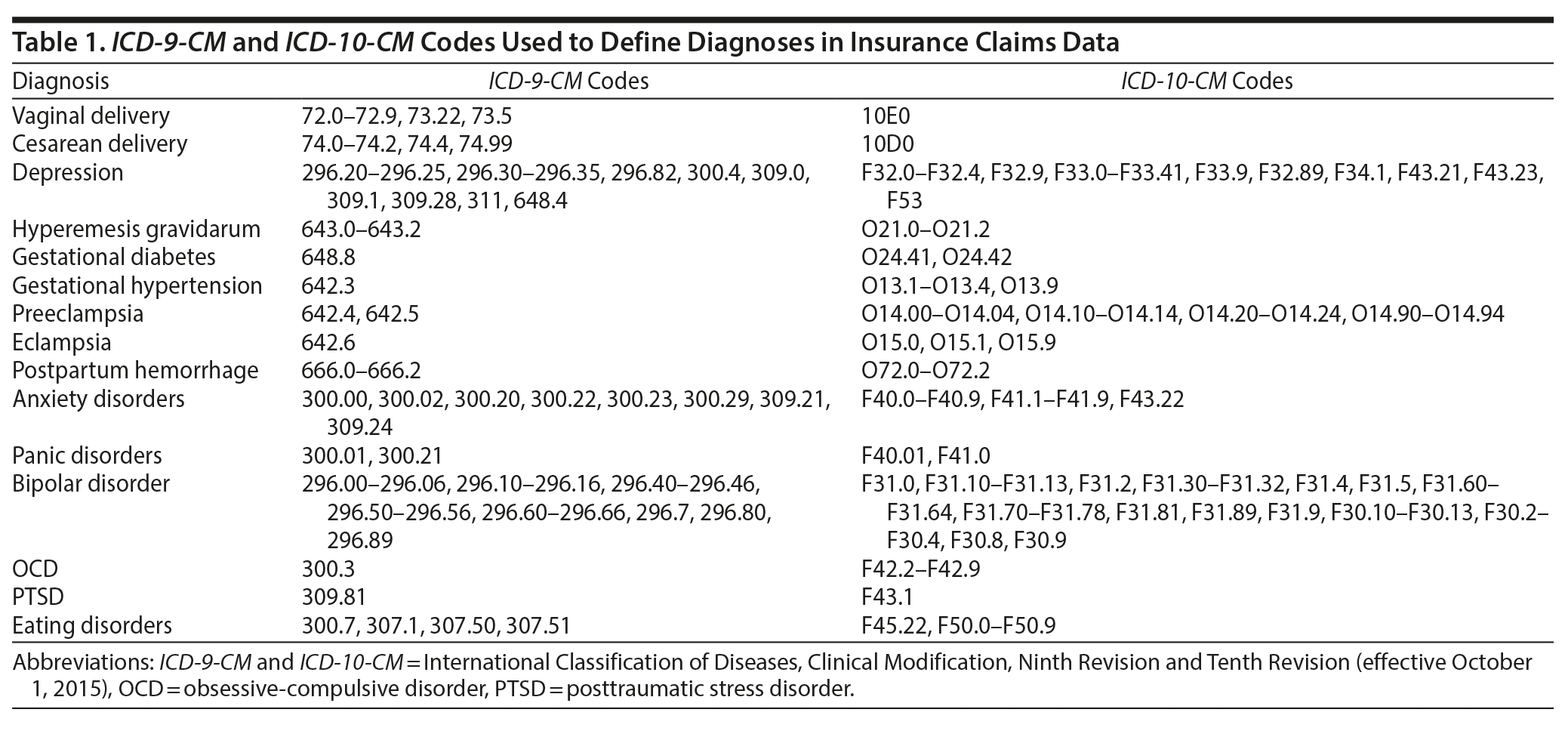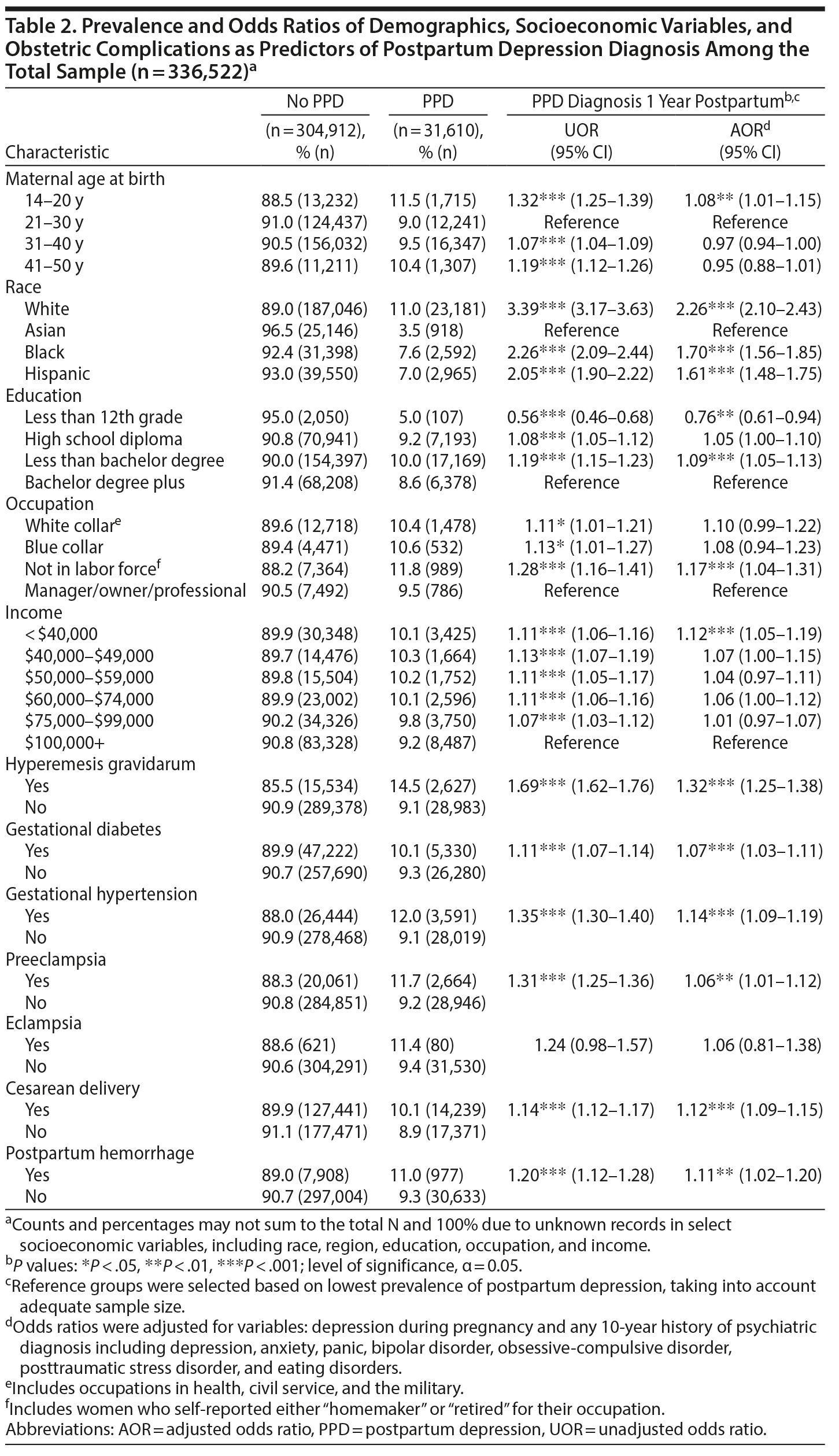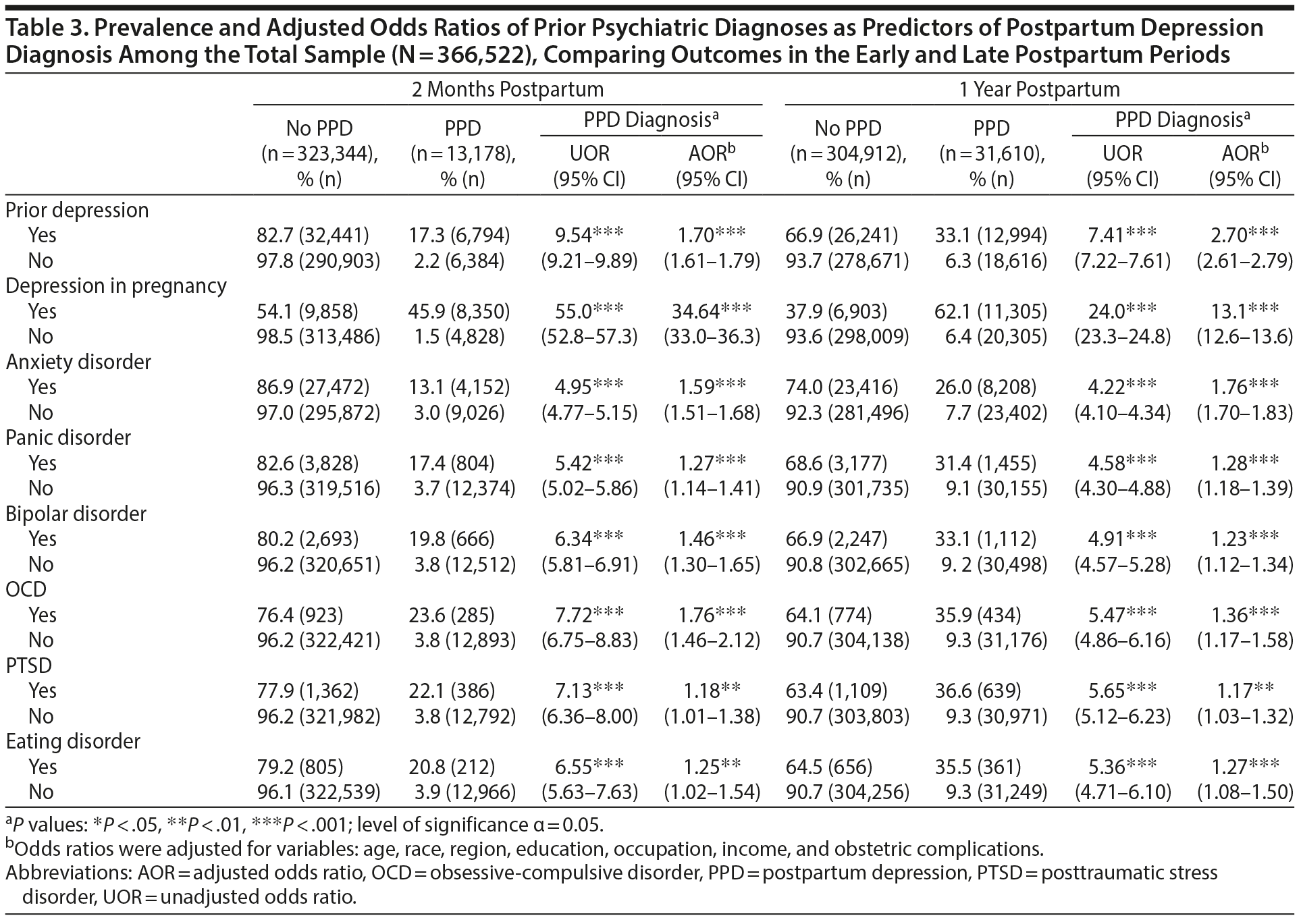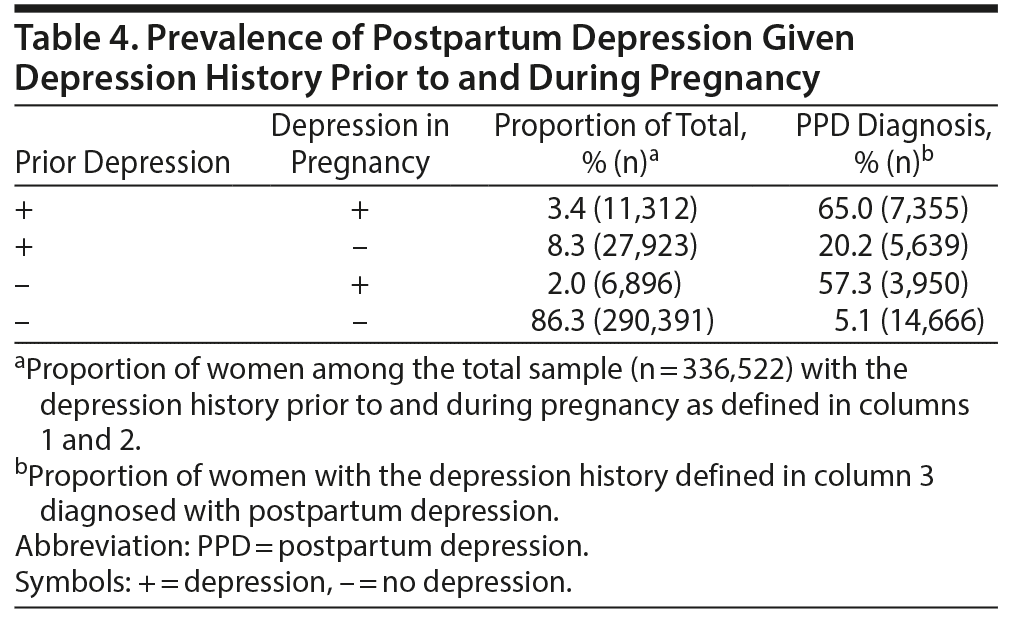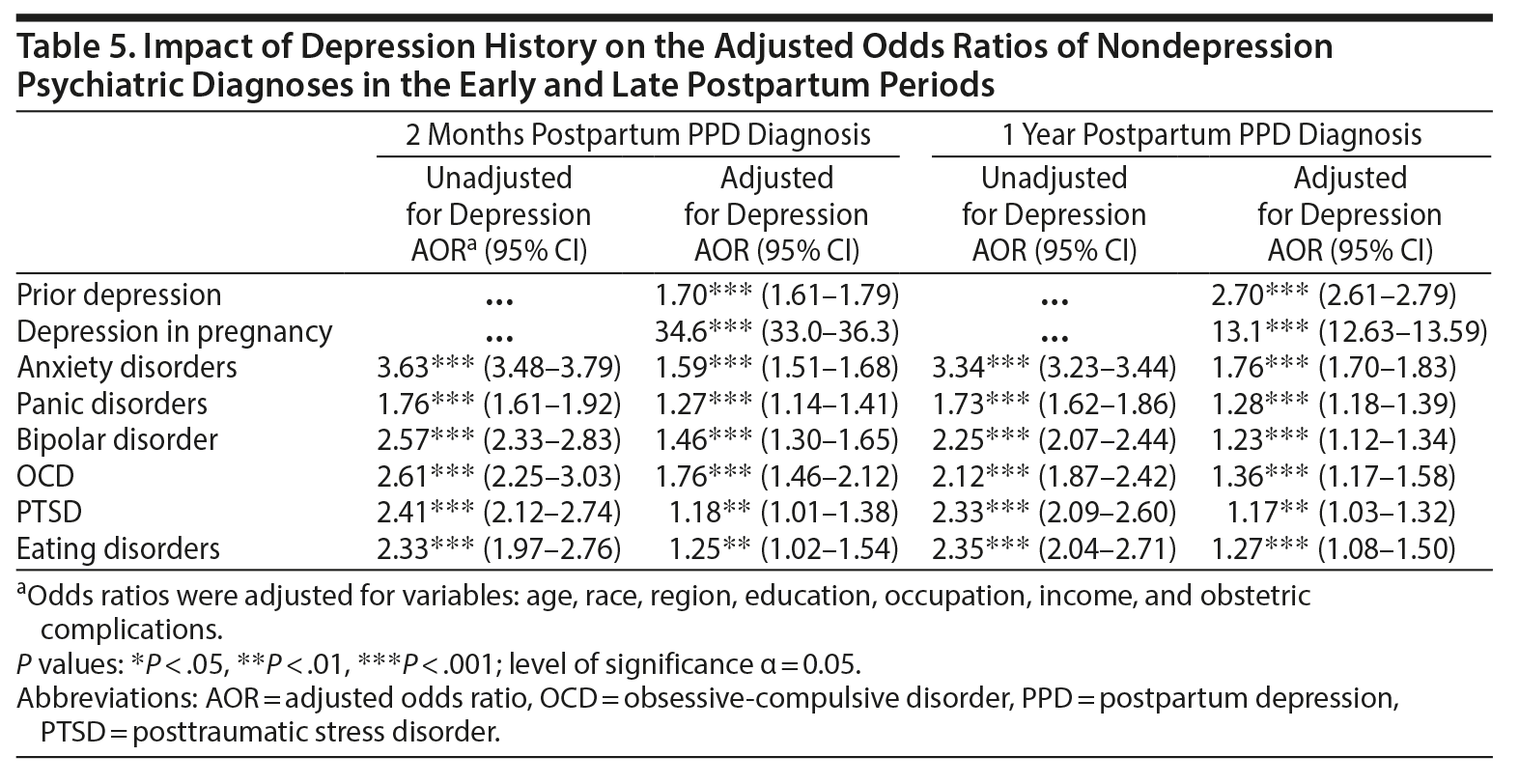Objective: To compare risk for postpartum depression across prior psychiatric diagnoses.
Methods: The deidentified Optum© Clinformatics Data Mart of national commercial insurance claims was used to identify 1,166,577 women of reproductive age with first-observed incidence of pregnancy across all 50 United States from 2003 to 2016. Women with insurance coverage for at least 6 months prior to conception and following delivery were eligible (n = 336,522). Psychiatric diagnoses prior to pregnancy were identified by ICD-9-CM and ICD-10-CM codes, including depression, anxiety and panic disorders, bipolar disorder, obsessive-compulsive disorder, posttraumatic stress disorder, and eating disorders. Primary outcomes included postpartum depression diagnosis at 2 months and 1 year after delivery. Multiple variable logistic regression analysis assessed for independent associations between predictors and outcomes.
Results: Among 336,522 pregnancies, 9.4% of women were diagnosed with postpartum depression (n = 31,610). Five percent of women with no depression history developed postpartum depression, compared to 65% of women with depression prior to and during pregnancy. Among women with history of depression who were euthymic during pregnancy, 20% were diagnosed with postpartum depression. A major risk factor was a history of depression (OR = 2.7; 95% CI, 2.6-2.8; P < .001), and depression in pregnancy was a risk factor for continued depression in the postpartum period (OR = 13.1; 95% CI, 12.6-13.6; P < .001). All other psychiatric conditions, including anxiety and panic disorders, bipolar disorder, obsessive-compulsive disorder, posttraumatic stress disorder, and eating disorders, conferred risk for postpartum depression, independent of a comorbid depression history.
Conclusions: We report that all psychiatric diagnoses investigated independently increase risk for postpartum depression and suggest that care providers inquire about psychiatric history to identify and closely monitor women at increased risk for postpartum depression.
This CME activity is expired. For more CME activities, visit CMEInstitute.com.
Find more articles on this and other psychiatry and CNS topics:
The Journal of Clinical Psychiatry
The Primary Care Companion for CNS Disorders
This work may not be copied, distributed, displayed, published, reproduced, transmitted, modified, posted, sold, licensed, or used for commercial purposes. By downloading this file, you are agreeing to the publisher’s Terms & Conditions.

CME Background
Articles are selected for credit designation based on an assessment of the educational needs of CME participants, with the purpose of providing readers with a curriculum of CME articles on a variety of topics throughout each volume. Activities are planned using a process that links identified needs with desired results.
To obtain credit, read the article, correctly answer the questions in the Posttest, and complete the Evaluation. A $10 processing fee will apply.
CME Objective
After studying this article, you should be able to:
- Evaluate patients’ psychiatric history to identify women at increased risk for postpartum depression
Accreditation Statement
The CME Institute of Physicians Postgraduate Press, Inc., is accredited by the Accreditation Council for Continuing Medical Education to provide continuing medical education for physicians.
Credit Designation
The CME Institute of Physicians Postgraduate Press, Inc., designates this journal-based CME activity for a maximum of 1 AMA PRA Category 1 Credit™. Physicians should claim only the credit commensurate with the extent of their participation in the activity.
Note: The American Academy of Physician Assistants (AAPA) accepts certificates of participation for educational activities certified for AMA PRA Category 1 Credit™ from organizations accredited by ACCME or a recognized state medical society. Physician assistants may receive a maximum of 1 hour of Category I credit for completing this program.
Release, Expiration, and Review Dates
This educational activity was published in January 2020 and is eligible for AMA PRA Category 1 Credit™ through February 28, 2022. The latest review of this material was December 2019.
Financial Disclosure
All individuals in a position to influence the content of this activity were asked to complete a statement regarding all relevant personal financial relationships between themselves or their spouse/partner and any commercial interest. The CME Institute has resolved any conflicts of interest that were identified. In the past year, Marlene P. Freeman, MD, Editor in Chief, has received research funding from JayMac and Sage; has been a member of the advisory boards for Otsuka, Alkermes, and Sunovion; has been a member of the Independent Data Safety and Monitoring Committee for Janssen; has been a member of the Steering Committee for Educational Activities for Medscape; and, as a Massachusetts General Hospital (MGH) employee, works with the MGH National Pregnancy Registry, which is sponsored by Teva, Alkermes, Otsuka, Actavis, and Sunovion, and works with the MGH Clinical Trials Network and Institute, which receives research funding from multiple pharmaceutical companies and the National Institute of Mental Health. No member of the CME Institute staff reported any relevant personal financial relationships. Faculty financial disclosure appears at the end of the article.
ABSTRACT
Objective: To compare risk for postpartum depression across prior psychiatric diagnoses.
Methods: The deidentified Optum© Clinformatics Data Mart of national commercial insurance claims was used to identify 1,166,577 women of reproductive age with first-observed incidence of pregnancy across all 50 United States from 2003 to 2016. Women with insurance coverage for at least 6 months prior to conception and following delivery were eligible (n = 336,522). Psychiatric diagnoses prior to pregnancy were identified by ICD-9-CM and ICD-10–CM codes, including depression, anxiety and panic disorders, bipolar disorder, obsessive-compulsive disorder, posttraumatic stress disorder, and eating disorders. Primary outcomes included postpartum depression diagnosis at 2 months and 1 year after delivery. Multiple variable logistic regression analysis assessed for independent associations between predictors and outcomes.
Results: Among 336,522 pregnancies, 9.4% of women were diagnosed with postpartum depression (n = 31,610). Five percent of women with no depression history developed postpartum depression, compared to 65% of women with depression prior to and during pregnancy. Among women with history of depression who were euthymic during pregnancy, 20% were diagnosed with postpartum depression. A major risk factor was a history of depression (OR = 2.7; 95% CI, 2.6-2.8; P < .001), and depression in pregnancy was a risk factor for continued depression in the postpartum period (OR = 13.1; 95% CI, 12.6-13.6; P < .001). All other psychiatric conditions, including anxiety and panic disorders, bipolar disorder, obsessive-compulsive disorder, posttraumatic stress disorder, and eating disorders, conferred risk for postpartum depression, independent of a comorbid depression history.
Conclusions: We report that all psychiatric diagnoses investigated independently increase risk for postpartum depression and suggest that care providers inquire about psychiatric history to identify and closely monitor women at increased risk for postpartum depression.
J Clin Psychiatry 2020;81(1):19m12929
To cite: Johansen SL, Stenhaug BA, Robakis TK, et al. Past psychiatric conditions as risk factors for postpartum depression: a nationwide cohort study. J Clin Psychiatry. 2020;81(1):19m12929.
To share: https://doi.org/10.4088/JCP.19m12929
© Copyright 2020 Physicians Postgraduate Press, Inc.
aDepartment of Psychiatry and Behavioral Sciences, Stanford University, Stanford, California
bStanford University Graduate School of Education, Stanford, California
cCenter for Population Health Sciences, Stanford University, Palo Alto, California
*Corresponding author: Sara L. Johansen, MD, Department of Psychiatry and Behavioral Sciences, Stanford University, 401 Quarry Rd, Stanford, CA 94305 ([email protected]).
Perinatal depression is among the most common morbidities of the perinatal period, affecting 12%-13% of women.1,2 Perinatal depression is defined as a major depressive episode occurring during pregnancy or up to 4 weeks postpartum3; however, in both research and clinical practice this definition variably extends to 3 months, 6 months, and 1 year postpartum.4 The US Preventive Services Task Force, American College of Obstetricians and Gynecologists,5 and American Academy of Pediatrics6 recommend screening with a validated tool such as the Edinburgh Postnatal Depression Scale7 during pregnancy and postpartum. Compared to usual care, universal depression screening leads to higher rates of diagnosis and treatment.8 High-risk women should be followed more closely than a simple one-time screen during the perinatal period permits, and defining pertinent risk factors is critical.
A recent study including over 5 million individuals showed that all mental disorders increase risk for all future mental disorders in the general population,9 but research on how this risk manifests in perinatal populations is lacking. Research shows that lifetime histories of depression,10-13 postpartum depression,14-16 anxiety,17 bipolar disorder,18 premenstrual dysphoric disorder,16,19 and eating disorders20,21 increase postpartum depression risk, but research to compare risk across multiple past psychiatric conditions in large samples is limited. One study compared relative contributions of past psychiatric conditions to postpartum depression risk in a majority black community in North Carolina.17 In nationwide population-based studies that compare risk for postpartum depression across psychiatric conditions, reported results are inconsistent and limited by sample size.22,23 A recently published study used a large Danish cohort to compare postpartum depression risk across psychiatric diagnoses in the maternal family psychiatric history but did not address the psychiatric history of the mothers themselves.24 Another study examined the recurrence risk of postpartum depression but selected for women with no prior psychiatric history.15 Thus, the existing evidence is inconclusive regarding the relative effect of past psychiatric conditions on postpartum depression risk.
We compare risk for postpartum depression across multiple psychiatric diagnoses using one of the largest US cohorts, representing all 50 states in a dataset of over 300,000 pregnancies. Our primary outcomes are postpartum depression diagnosis at 2 months and 1 year after delivery. We identify prior psychiatric conditions that are risk factors for postpartum depression. This research suggests that providers should inquire about psychiatric history to support close monitoring of women at high risk for postpartum depression.

- It is widely known that specific preexisting psychiatric diagnoses increase risk for postpartum depression, but the risks of past psychiatric diagnoses on postpartum depression risk have rarely been compared in large samples across diagnoses.
- In one of the largest nationwide US cohort analyses, we report that all psychiatric diagnoses investigated increase risk for postpartum depression independent of a comorbid depression history.
- Care providers should inquire into psychiatric history in early pregnancy in order to identify women at increased risk for postpartum depression who would benefit from careful observation in the perinatal period.
METHODS
This retrospective cohort study used commercial insurance claims data to identify predictors of postpartum depression. We identified 1,166,577 women of reproductive age (14 to 50 years) with a first-observed incidence of pregnancy ending in 1 or more live births between January 2003 and December 2016. “First-observed” refers to the first pregnancy with an insurance claim. From this cohort, 336,522 women with continuous insurance coverage for at least 6 months prior to conception and 6 months following delivery were eligible. Some period of continuous insurance was required, and although this method selects against women who lose insurance, 73% (n = 244,514) of the total cohort were still enrolled at 1 year postpartum. Multiple gestations in a single pregnancy were included. A total of 261,811 women with multiple separate pregnancies were excluded because this dataset cannot distinguish between postpartum depression and antepartum depression for women with another pregnancy in the first postpartum year. Sensitivity analysis indicated that results were not significantly different when multiple separate pregnancies were excluded from the cohort. Select individuals with insurance claims for delivery were excluded; 2,535 subjects were excluded due to male gender (n = 2,421) and unknown gender (n = 114), and 1,484 subjects were excluded due to maternal age outside the chosen period of reproductive potential (480 subjects ages 0 to 13 years; 1,004 subjects ages 51 to 88 years).
Institutional Review Board approval was obtained at Stanford University. All data were obtained from Optum© Clinformatics Data Mart, a deidentified database from a national insurance provider. We defined the pregnancy period by estimating conception at 39 weeks prior to delivery. Procedure codes corresponding to vaginal and cesarean delivery were selected using the International Classification of Disease, Clinical Modification, Ninth Revision (ICD-9-CM) and Tenth Revision (ICD-10–CM, effective October 1, 2015), as noted in Table 1.
The primary outcomes were depression diagnosis at 2 months and 1 year postpartum (Table 1). The 2-month time point was chosen to maximize specificity for early postpartum onset, while leaving sufficient time for a depression diagnosis to be recorded, since most postpartum women do not receive medical attention until the 6-week postpartum visit. The 1-year time point was chosen to maximize sensitivity for detection of individuals who do not present until later in the postpartum course, as is often the case in postpartum depression.25,26
Using previously established methods,27 for diagnoses billed under “Mental Disorders Specific to Pregnancy,” which encompasses multiple disorders, the diagnosis qualified as depression if an antidepressant medication was filled within 30 days of diagnosis. Recognizing the limitation that antidepressant medications can have multiple indications, we did not use medications to define depression for billing codes that specifically refer to a depression diagnosis.
We assessed postpartum antidepressant treatment, defined by at least 1 medication dispensed in pharmacy claims data. Antidepressant medications included selective serotonin reuptake inhibitors (SSRIs; citalopram, escitalopram, fluoxetine, fluvoxamine, paroxetine, sertraline), tricyclics (amitriptyline, clomipramine, desipramine, doxepin, imipramine, and nortriptyline), monoamine oxidase inhibitors (isocarboxazid, phenelzine, selegiline, tranylcypromine), and others (bupropion, mirtazapine, nefazodone, trazodone, venlafaxine).
Predictors were analyzed for associations with outcomes, including demographic and socioeconomic variables, obstetric complications, and psychiatric diagnoses prior to pregnancy, including depression, anxiety disorders, panic disorders, bipolar disorder, obsessive-compulsive disorder (OCD), posttraumatic stress disorder (PTSD), and eating disorders (Table 1). Psychiatric diagnoses were identified over a 10-year period prior to estimated conception, selected based on analyses indicating that 10 years captured the entirety of an individual’s coverage period through Optum for the majority of individuals.
The total sample size in all statistical analyses was consistent (n = 336,522). In the cohort of 335,522 unique pregnancies, no imputation was required for the primary outcomes of postpartum depression diagnosis at 2 months and 1 year postpartum. Select individuals had missing data in socioeconomic predictors and were included with “response unknown” in analysis; therefore, counts and percentages for socioeconomic predictors may not sum to the total N and 100% (Table 2).
We used multiple variable logistic regression analysis to assess for independent associations between predictors and primary outcomes. Due to extensive comorbidity among variables in psychiatric history and tested outcomes, in which of the 31,610 individuals diagnosed with postpartum depression, 60.2% had a history of at least 1 additional psychiatric diagnosis, we did not correct for multiple hypotheses. Sensitivity analysis was used to evaluate the effect of variables for cohort selection on outcomes. Reference groups were chosen based on the group at lowest risk for postpartum depression, considering adequate sample size. Results of logistic regression analysis were reported as odds ratios with 95% confidence intervals (CI) and level of significance at α = .05.
RESULTS
Prevalence of Postpartum Depression and Past Psychiatric Conditions
The majority of women in the study were white (62.5%), were between the ages of 31-40 years (51.2%), and had obtained some college education (51.0%; Table 2). Among the 336,522 pregnancies, 9.4% of women received a depression diagnosis in the first postpartum year (n = 31,610; Table 3). This prevalence was stable throughout the study period from 2003 to 2016. The first 2 months postpartum represented the period of highest risk. Of the 31,610 women diagnosed with postpartum depression, 41.7% (n = 13,178) presented within the first 2 months (Table 3).
Among women with depression, 47.2% were diagnosed with “mental disorders specific to pregnancy” (n = 14,927), 46.8% with “depressive disorder NOS” (n = 14,806), 21.1% with “major depression” (n = 6,685), 11.3% with “dysthymic disorder” (n = 3,565), 11.1% with “adjustment disorder with mixed anxiety and depressed mood” (n = 3,511), and 5.3% with “adjustment disorder with depressed mood or prolonged depressive reaction” (n = 1,686).
Postpartum depression prevalence varied depending on depression history (Table 4). Women with any previous history of depression accounted for 53.6% of cases of postpartum depression. Of the 31,610 women with postpartum depression, 60.2% had a history of at least 1 additional psychiatric diagnosis. Among the total cohort, 11.7% (39,235) had a prior diagnosis of depression, 9.4% (31,624) with an anxiety disorder, 1.4% (4,632) with panic disorder, 1.0% (3,359) with bipolar disorder, 0.4% (1,208) with OCD, 0.5% (1,748) with PTSD, and 0.3% (1,017) with an eating disorder.
Prevalence of Antepartum and Postpartum Treatment
Sixty-seven percent of women with postpartum depression received antidepressant medication in the first postpartum year (n = 21,176). The majority received SSRIs (82.7%, n = 17,518), most commonly sertraline (n = 8,614) and escitalopram (n = 3,206). Of the 18,208 women with depression during pregnancy, 46.7% received antidepressant treatment during pregnancy (n = 8,509). Seventy-four percent (n = 6,297) received treatment with SSRIs, most commonly sertraline (n = 2,679) and fluoxetine (n = 1,327).
Risk Factors for Postpartum Depression
History of depression conferred the greatest increase in postpartum depression risk in the first postpartum year (OR = 2.7; 95% CI, 2.61-2.79; P < .001; Table 3). Depression during pregnancy was a risk factor for continued depression postpartum (OR = 13.1; 95% CI, 12.6-13.6; P < .001). All other psychiatric diagnoses increased postpartum depression risk at both 2 months and 1 year postpartum, although adjustment for comorbid depression reduced all odds ratios for nondepressive psychiatric illnesses to 1.7 or less (Table 5; crude odds ratios are presented in Table 3). Among nondepressive psychiatric illnesses, anxiety carried the greatest risk for postpartum depression at 1 year postpartum (adjusted odds ratio [AOR] = 1.8; 95% CI, 1.70-1.83; P < .001; Table 5), and PTSD, the least risk (AOR = 1.2; 95% CI, 1.03-1.32; P < .01; Table 5). Changing the definition of the postpartum period (2 months versus 1 year) did not have any systematic effect on AORs for the various psychiatric disorders, with the exception of depression during pregnancy, which was associated with greater risk of continuation of the antenatal depression episode in early postpartum (AOR = 34.6; 95% CI, 33.0-36.3; P < .001; Table 5).
Our results affirm previous findings that younger women, women not in the labor force, and women in the lowest income bracket are at increased risk for postpartum depression. Additionally, all obstetric disorders except eclampsia were associated with small but measurable increases in risk for postpartum depression, with adjusted ORs typically around 1.1 (Table 2).
DISCUSSION
Four major results highlight the importance of inquiring about past psychiatric history to support careful observation of high-risk women during pregnancy: (1) prevalence of postpartum depression varies significantly depending on depression history; (2) history of depression confers the greatest risk for postpartum depression, and prior psychiatric conditions including anxiety disorders, panic disorders, bipolar disorder, OCD, PTSD, and eating disorders are all significantly positively associated with postpartum depression even after controlling for comorbid depression; (3) postpartum depression diagnoses are concentrated in the first 2 months after delivery compared to later in the postpartum year, particularly among women with prior psychiatric conditions; and (4) a high proportion of women with depression during pregnancy and postpartum do not receive pharmacotherapy.
The overall mean prevalence of 9.4% that we report is consistent with literature on postpartum depression prevalence1,2,28; however, our data indicate that this prevalence varies depending on depression history. Only 5% of women with no depression before or during pregnancy developed postpartum depression, compared to 65% of women with depression prior to and during pregnancy. Even among women with a history of depression who were euthymic during pregnancy, 20% developed postpartum depression. These data emphasize that prior depression is a major risk factor for postpartum depression, and women with depression during pregnancy are at high risk for continued depression in the postpartum period.
While prior depression is a known risk factor for postpartum depression,11 population-based studies that examine risk across multiple psychiatric diagnoses are limited by sample size and conflicting evidence.22,23 In this study, all psychiatric conditions investigated, including anxiety disorders, panic disorders, bipolar disorder, OCD, PTSD, and eating disorders, increased postpartum depression risk. While much of their effect is explained by comorbid depression, all of these conditions conferred a significant increase in postpartum depression risk even when adjusting for depression prior to and during pregnancy. Of note, in presenting adjusted odds ratios, we included variables that are causally related to depression, thus diluting the strength of the observed association. For clinicians selecting high-risk patients for monitoring, unadjusted odds ratios are likely the most accurate guide to overall risk assessment.
We identified the early postpartum as the period of greatest risk for onset of depression, as approximately half of the women who developed depression within 1 year of delivery presented within the first 2 months. While our dataset did not allow us to distinguish time of depression onset from time of recorded diagnosis, our comparison of the 2-month and 1-year prevalence does confirm that early postpartum is a period of elevated risk for clinical depression. The American Psychiatric Association recommends depression screening in early pregnancy for a range of preexisting psychiatric disorders.29 Our research supports this recommendation to allow for careful observation of high-risk women during the perinatal period.
Furthermore, women with prior psychiatric conditions were more likely to present in the early postpartum; for all prior psychiatric conditions, between one-half and two-thirds of women who developed postpartum depression presented in the first 2 months, compared to one-third of women without a psychiatric history who presented in the early postpartum. While prospective longitudinal data suggest that depression is greatest in the first few months postpartum,2,30 this effect may be due to increased familiarity with the mental health care system in women with prior psychiatric diagnoses compared to women without psychiatric history. Maternal lack of knowledge about postpartum depression and inability to disclose feelings to health professionals are identified across studies as major barriers to seeking care.25 These barriers may be diminished in women with experience recognizing depression symptoms as pathological. These data suggest that women with prior psychiatric history should be closely followed during the early postpartum period.
Pharmacologic treatment of depression for women diagnosed during pregnancy and postpartum was low with only 46.7% and 67.0% of depressed women receiving antidepressant treatment during pregnancy and postpartum, respectively; however, these results are consistent with treatment rates in other claims studies.27,31 We did not have data on psychotherapeutic treatment. The US Preventive Services Task Force recommends counseling interventions, including cognitive behavioral therapy and interpersonal therapy, to prevent perinatal depression.32 Survey data indicate that 55% of women prefer treatment with a combination of medications and counseling, compared to counseling alone (22%) and no treatment (8%).33 Treatment involves careful risk-benefit analysis, particularly during pregnancy.34
All 336,522 pregnancies represent the first observed incidence of pregnancy per woman between 2003 and 2016. Prior births that occurred without Optum insurance would not be captured. As postpartum depression is a recurrent disorder, this is an important limitation. Additionally, these data are representative of commercially insured individuals. A database that included publicly insured and uninsured individuals may yield different baseline rates.
The 9.4% prevalence that we report is less than the 12%-13% prevalence documented in the literature.1,2 Compared to clinical interview, the inexactness of chart diagnoses, which limits inclusion to individuals with formally recorded diagnoses, and pharmacy logs, in which antidepressants may be prescribed for alternative indications, is a limitation inherent to claims data that rely on provider billing. Psychiatric diagnoses may be underreported either because providers hesitate to document for fear of stigma or difficulty obtaining insurance coverage or because psychiatric care may be sought outside of insurance entirely. Only half of practicing psychiatrists in the United States accept insurance,35 and prior to the passage of the Mental Health Parity and Addiction Equity Act in 2008, psychiatric care was often not covered or covered minimally under insurance. Thus, our numbers are an underrepresentation of the true prevalence of mental illness in our study population.
We attempted to address this limitation by including a range of depression diagnoses, including nonparity diagnoses which some providers may have preferred prior to 2010, when preexisting condition clauses for privately purchased health insurance were outlawed by passage of the Patient Protection and Affordable Care Act. Overall, these methods allow us to capture a broad range of mild to severe depression requiring treatment. The issue of treatment-seeking versus treatment-capture should be relatively constant across psychiatric diagnoses, so it is less likely to bias our analysis of psychiatric conditions as risk factors for postpartum depression.
Some period of continuous insurance was required to adequately assess the maternal course, but this method selects against women who lose insurance. Variability in insurance coverage duration introduces additional underestimation into our assessment of psychiatric history. The 10-year period for identifying prior psychiatric diagnoses was selected because this period encompassed the entirety of an individual’s coverage period for the majority of individuals. Most women did not have Optum insurance coverage for longer than 5 years, and women with previously existing psychiatric diagnoses who were not insured through Optum at the time of diagnosis would not be identified in our data, which biases our data toward underrepresenting the true prevalence of preexisting psychiatric illness. Nonetheless, this underestimation of the true population prevalence should not introduce systematic error into determination of risks conferred by preexisting mental illness, which is the focus of this article.
Future Directions
Given the many limitations of claims-based datasets, prospectively designed studies are needed. In addition, although recent years have brought extensive calls for increased monitoring of mental health in perinatal women, our understanding of what resources are offered or accepted by screen-positive women, and what benefits are conferred by these interventions, remains unclear. Future studies are needed to identify the most effective interventions for women with postpartum depression. In particular, improved understanding of how women with and without prior psychiatric diagnoses are able to navigate psychiatric care would help improve the provision of perinatal mental health care overall.
CONCLUSIONS
These data suggest that care providers should inquire about psychiatric history and carefully follow women with prior psychiatric history throughout the perinatal period.
Submitted: May 24, 2019; accepted September 3, 2019.
Published online: January 21, 2020.
Disclosure of off-label usage: The authors have determined that, to the best of their knowledge, no investigational information about pharmaceutical agents or device therapies that is outside US Food and Drug Administration-approved labeling has been presented in this article.
Financial disclosure: Drs Johansen, Robakis, Williams, and Cullen and Mr Stenhaug have no personal affiliations or financial relationships with any commercial interest to disclose relative to the article.
Funding/support: This research was supported by the Stanford University School of Medicine Medical Scholars Fellowship in Stanford, California. This fellowship provided tuition and stipend to support the first author in full-time research.
Role of the sponsor: The funding was not used for the conduct or publication of this study.
Previous presentation: Poster presentation at the Annual Meeting of the American Psychiatric Association; May 5-9, 2018; New York, New York.
Additional information: Authors obtained full access to Optum© Clinformatics Data Mart through the Stanford University Center for Population Health Sciences. Access to this data set is ongoing.
REFERENCES
1.Woody CA, Ferrari AJ, Siskind DJ, et al. A systematic review and meta-regression of the prevalence and incidence of perinatal depression. J Affect Disord. 2017;219:86-92. PubMed CrossRef
2.Gavin NI, Gaynes BN, Lohr KN, et al. Perinatal depression: a systematic review of prevalence and incidence. Obstet Gynecol. 2005;106(5 pt 1):1071-1083. PubMed CrossRef
3.American Psychiatric Association. Diagnostic and Statistical Manual for Mental Disorders. Fifth Edition. Washington, DC: American Psychiatric Association; 2013.
4.Stewart DE, Vigod S. Postpartum depression. N Engl J Med. 2016;375(22):2177-2186. PubMed CrossRef
5.Committee on Obstetric Practice. The American College of Obstetricians and Gynecologists Committee Opinion No. 630: screening for perinatal depression. Obstet Gynecol. 2015;125(5):1268-1271. PubMed CrossRef
6.Earls MF; Committee on Psychosocial Aspects of Child and Family Health American Academy of Pediatrics. Incorporating recognition and management of perinatal and postpartum depression into pediatric practice. Pediatrics. 2010;126(5):1032-1039. PubMed CrossRef
7.Cox JL, Holden JM, Sagovsky R. Detection of postnatal depression: development of the 10-item Edinburgh Postnatal Depression Scale. Br J Psychiatry. 1987;150(6):782-786. PubMed CrossRef
8.Yawn BP, Dietrich AJ, Wollan P, et al; TRIPPD practices. TRIPPD: a practice-based network effectiveness study of postpartum depression screening and management. Ann Fam Med. 2012;10(4):320-329. PubMed CrossRef
9.Plana-Ripoll O, Pedersen CB, Holtz Y, et al. Exploring comorbidity within mental disorders among a Danish national population. JAMA Psychiatry. 2019;76(3):259-270. PubMed CrossRef
10.Howard LM, Molyneaux E, Dennis CL, et al. Non-psychotic mental disorders in the perinatal period. Lancet. 2014;384(9956):1775-1788. PubMed CrossRef
11.Guintivano J, Manuck T, Meltzer-Brody S. Predictors of postpartum depression: a comprehensive review of the last decade of evidence. Clin Obstet Gynecol. 2018;61(3):591-603. PubMed
12.Suri R, Stowe ZN, Cohen LS, et al. Prospective longitudinal study of predictors of postpartum-onset depression in women with a history of major depressive disorder. J Clin Psychiatry. 2017;78(8):1110-1116. PubMed CrossRef
13.Witt WP, Wisk LE, Cheng ER, et al. Poor prepregnancy and antepartum mental health predicts postpartum mental health problems among US women: a nationally representative population-based study. Womens Health Issues. 2011;21(4):304-313. PubMed CrossRef
14.Dennis CL, Brown HK, Wanigaratne S, et al. Determinants of comorbid depression and anxiety postnatally: a longitudinal cohort study of Chinese-Canadian women. J Affect Disord. 2018;227:24-30. PubMed CrossRef
15.Rasmussen MH, Str׸m M, Wohlfahrt J, et al. Risk, treatment duration, and recurrence risk of postpartum affective disorder in women with no prior psychiatric history: a population-based cohort study. PLoS Med. 2017;14(9):e1002392. PubMed CrossRef
16.Turkcapar AF, Kadıoğlu N, Aslan E, et al. Sociodemographic and clinical features of postpartum depression among Turkish women: a prospective study. BMC Pregnancy Childbirth. 2015;15(1):108-115. PubMed CrossRef
17.Guintivano J, Sullivan PF, Stuebe AM, et al. Adverse life events, psychiatric history, and biological predictors of postpartum depression in an ethnically diverse sample of postpartum women. Psychol Med. 2018;48(7):1190-1200. PubMed CrossRef
18.Viguera AC, Tondo L, Koukopoulos AE, et al. Episodes of mood disorders in 2,252 pregnancies and postpartum periods. Am J Psychiatry. 2011;168(11):1179-1185. PubMed CrossRef
19.Bloch M, Rotenberg N, Koren D, et al. Risk factors for early postpartum depressive symptoms. Gen Hosp Psychiatry. 2006;28(1):3-8. PubMed CrossRef
20.Meltzer-Brody S, Zerwas S, Leserman J, et al. Eating disorders and trauma history in women with perinatal depression. J Womens Health (Larchmt). 2011;20(6):863-870. PubMed CrossRef
21.Micali N, Simonoff E, Treasure J. Pregnancy and post-partum depression and anxiety in a longitudinal general population cohort: the effect of eating disorders and past depression. J Affect Disord. 2011;131(1-3):150-157. PubMed CrossRef
22.Tebeka S, Strat YL, Dubertret C. Developmental trajectories of pregnant and postpartum depression in an epidemiologic survey. J Affect Disord. 2016;203:62-68. PubMed CrossRef
23.Le Strat Y, Dubertret C, Le Foll B. Prevalence and correlates of major depressive episode in pregnant and postpartum women in the United States. J Affect Disord. 2011;135(1-3):128-138. PubMed CrossRef
24.Bauer AE, Maegbaek ML, Liu X, et al. Familiality of psychiatric disorders and risk of postpartum psychiatric episodes: a population-based cohort study. Am J Psychiatry. 2018;175(8):783-791. PubMed CrossRef
25.Dennis CL, Chung-Lee L. Postpartum depression help-seeking barriers and maternal treatment preferences: a qualitative systematic review. Birth. 2006;33(4):323-331. PubMed CrossRef
26.Sword W, Busser D, Ganann R, et al. Women’s care-seeking experiences after referral for postpartum depression. Qual Health Res. 2008;18(9):1161-1173. PubMed CrossRef
27.Dietz PM, Williams SB, Callaghan WM, et al. Clinically identified maternal depression before, during, and after pregnancies ending in live births. Am J Psychiatry. 2007;164(10):1515-1520. PubMed CrossRef
28.Wisner KL, Sit DK, McShea MC, et al. Onset timing, thoughts of self-harm, and diagnoses in postpartum women with screen-positive depression findings. JAMA Psychiatry. 2013;70(5):490-498. PubMed CrossRef
29.Position Statement on Screening and Treatment of Mood and Anxiety Disorders During Pregnancy and Postpartum. American Psychiatric Association website. http://www.psychiatry.org/File%20Library/About-APA/Organization-Documents-Policies/Policies/Position-Screening-and-Treatment-Mood-Anxiety-Disorders-During-Pregnancy-Postpartum.pdf. 2018.
30.Robakis TK, Williams KE, Crowe S, et al. Maternal attachment insecurity is a potent predictor of depressive symptoms in the early postnatal period. J Affect Disord. 2016;190:623-631. PubMed CrossRef
31.Geier ML, Hills N, Gonzales M, et al. Detection and treatment rates for perinatal depression in a state Medicaid population. CNS Spectr. 2015;20(1):11-19. PubMed CrossRef
32.Curry SJ, Krist AH, Owens DK, et al; US Preventive Services Task Force. Interventions to prevent perinatal depression: US Preventive Services Task Force recommendation statement. JAMA. 2019;321(6):580-587. PubMed CrossRef
33.Patel SR, Wisner KL. Decision making for depression treatment during pregnancy and the postpartum period. Depress Anxiety. 2011;28(7):589-595. PubMed CrossRef
34.Wisner KL, Zarin DA, Holmboe ES, et al. Risk-benefit decision making for treatment of depression during pregnancy. Am J Psychiatry. 2000;157(12):1933-1940. PubMed CrossRef
35.Bishop TF, Press MJ, Keyhani S, et al. Acceptance of insurance by psychiatrists and the implications for access to mental health care. JAMA Psychiatry. 2014;71(2):176-181. PubMed CrossRef
Editor’s Note: We encourage authors to submit papers for consideration as a part of our Focus on Women’s Mental Health section. Please contact Marlene P. Freeman, MD, at [email protected].
This PDF is free for all visitors!
